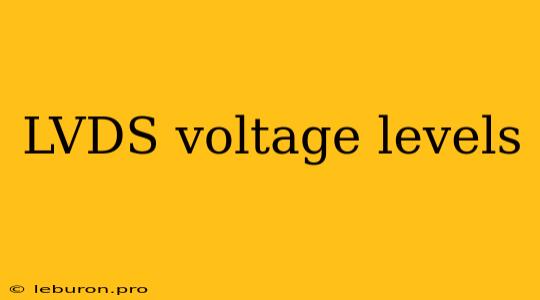Low-voltage differential signaling (LVDS) is a type of electrical signaling used in high-speed digital communication systems. It is a popular choice for applications requiring high bandwidth and low power consumption, making it suitable for devices like high-resolution displays, data acquisition systems, and high-speed networking equipment. One of the key characteristics of LVDS is its use of LVDS voltage levels, which differ significantly from traditional TTL or CMOS levels. This article delves into the specifics of LVDS voltage levels, exploring the reasons behind their use, their advantages, and how they impact system design considerations.
Understanding LVDS Voltage Levels
LVDS employs a differential signaling scheme, transmitting data using two signal lines: one carrying the positive signal and the other carrying the negative signal. The difference in voltage between these two lines, rather than the absolute voltage level of each line, represents the data. LVDS voltage levels typically fall within the range of ±350mV to ±500mV, significantly lower than the 0V to 5V levels found in traditional TTL or CMOS interfaces. This low voltage swing is one of the primary features that contributes to LVDS's high-speed capabilities and low power consumption.
Advantages of Low Voltage Swing
-
Reduced Power Consumption: The reduced voltage swing in LVDS voltage levels directly translates to lower power consumption. Power dissipation is proportional to the square of the voltage, so using low voltages significantly reduces the amount of energy wasted as heat. This is particularly beneficial in applications where power consumption is critical, such as mobile devices and portable electronics.
-
Improved Signal Integrity: Lower voltage swings minimize the effects of noise and crosstalk, which can distort signals during transmission, especially at high frequencies. The smaller voltage differences are less susceptible to interference, resulting in cleaner and more reliable data transmission.
-
Enhanced Signal Speed: Reduced voltage swings enable faster rise and fall times for signals, allowing for higher data transfer rates. This characteristic is essential in high-speed applications where data needs to be transmitted quickly and efficiently.
-
Increased Noise Immunity: The differential signaling scheme, combined with low voltage swings, provides inherent noise immunity. The receiver only recognizes the voltage difference between the two lines, effectively rejecting common-mode noise that affects both lines equally. This makes LVDS more robust to interference, particularly in electrically noisy environments.
Challenges and Design Considerations
While LVDS offers numerous advantages, some design considerations are crucial for successful implementation:
-
Signal Termination: Due to the low impedance of LVDS lines, proper termination is essential to prevent signal reflections that can distort data. Terminating resistors are typically placed at the receiving end of the transmission line to absorb reflected energy and ensure signal integrity.
-
Receiver Sensitivity: LVDS receivers are designed to detect the small voltage difference between the two signal lines. Therefore, noise and interference levels must be minimized to ensure accurate data reception. Careful routing and shielding can help reduce the impact of electromagnetic interference.
-
Driver Output Impedance: The output impedance of LVDS drivers must be carefully matched to the characteristic impedance of the transmission line. Mismatched impedance can lead to reflections and signal distortion, impacting data integrity.
-
Common-Mode Voltage: While LVDS receivers are insensitive to common-mode noise, large common-mode voltage swings can overload the receiver or damage the driver. Proper grounding and shielding techniques are essential to minimize common-mode voltages.
Conclusion
LVDS voltage levels play a pivotal role in enabling the high-speed, low-power performance of LVDS signaling. The low voltage swing offers significant advantages in terms of power consumption, signal integrity, noise immunity, and data transfer rate. Understanding these benefits and the associated design challenges is crucial for engineers developing systems that leverage LVDS technology. By implementing proper termination, minimizing noise and interference, and ensuring compatible driver and receiver characteristics, designers can maximize the benefits of LVDS signaling for high-speed communication applications.
